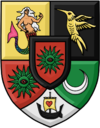Flag of Sabia and Verona
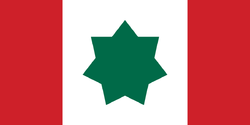 |
|
| Name | treteté |
|---|---|
| Use | Civil and state flag |
| Proportion | 1:2 |
| Adopted | 20 October 2012 |
| Design | A vertical bicolour triband of red, white, and red in the ratio 1:2:1, with a green heptagram charged in the centre. |
| Designed by | Tarik Kârjasary |
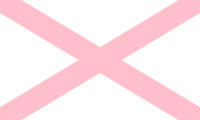 |
|
| Name | usu i arru |
| Use | War flag and national ensign |
| Proportion | 1:2 |
| Adopted | 2016 |
| Design | A pastel pink saltire on a white field. |
| Designed by | Tarik Kârjasary |
The flag of Sabia and Verona (Sabian: simorán), commonly known as the Treteté (tretetená) was officially adopted by Sabia and Verona on 20 October 2012, when the Kingdom was created. It can trace its origins back to the Nemkhav Republic of Berin, when an early version of the flag designed by Tarik Kârjasary was adopted by the Republic's provincial government. The flag was also used by the short-lived Federal Union of Cizland in April 2012.
In addition to the Treteté, another popular flag in Sabia and Verona is the usu i arru, which is currently used as the national ensign and war flag of the Kingdom and derives from the flag of the Holy Dussesh Empire. Its distinctive pastel pink and white colors are considered the co-official national colors of Sabia and Verona, and are commonly associated with the Valtirian Monarchy.
History

The first usage of the treteté was in September 2011 as the flag of the Republic of Berin, a province of the then Nemkhav Federation. The red intended to represent courage; green represented nature and the mountains surrounding the Valtir Area, and white represented peace and equality. The seven-pointed star represented the seven original countries of the Cizlandeese Empire: Salisse, High Cizland, Low Cizland, New Merida, Soberbia, Vadenbourg and Luftchen. The name "Treteté" allegedly comes from the Albanian "tre shtatë", literally meaning "Three-Seven" and reffering the three bars of the flag and seven points of the star. The flag's original run in Nemkhav Berin was from 18 September to 9 November 2011, when the Republic of Berin was dissolved and The Faryar was created.
It was proposed that Trinitagua, a nation-project walking hand in hand with Tiana that never came to be, adopted the treteté flag. But when the Principality of Montriac was created, all plans regarding Trinitagua were forgotten and the flag was left alone. The treteté was again adopted by the short-lived Federal Union of Cizland in April 2012 to conmemorate the seven provinces of the First Cizland. However the Federal Union didn't last long and it was mostly fantastical in nature.
After the Empire of Würdigeland failed to settle in Venezuela through the Colony of Listva, the Kingdom of Juclandia set eye on the Valtir Area. Sabia and Verona was founded on 20 October 2012. Two days earlier on 18 October the Courts of Sabia and Verona held their first meeting, where it was decided the treteté would be adopted as the new nation's ensign. On October 20 the flag was raised in the city of Alcabala, in the east of the Bal Prefecture. Later, the Sabioveronese government would finally regulate the flag's proportions, something past governments employing the flag had failed to do.
Design
The Constitution of Sabia and Verona states, regarding the national flag of the Kingdom:
The national flag of the Kingdom of Sabia and Verona will be a banner with the proportion of 1:2, with a Canadian pale of red, white and red, and with a green obtuse seven-pointed star in the centre.
— Article 69
The colours of the flag are a subject of debate. Traditionally the red and the green have been bright and they're often represented as such in materialized depictions. However, the Government has preferred to use paler and less saturized colours for the sake of graphic harmony. In 2015 the Sabioveronese government regulated the colours as being white, fire engine red and bottle green.
| Regulated colours (2015) | Red | White | Green |
|---|---|---|---|
| Hex triplet | #CE2029 | #FFFFFF | #006A48 |
| RGB | 206, 32, 41 | 255, 255, 255 | 0, 106, 78 |
Other flags
National
| Flag | Since | Use | Description |
|---|---|---|---|

|
2016 | War flag and national ensign |
A pink saltire on a white field. Known in Sabian as the usu i arru ("milk and strawberry") flag. Derived from the Imperial Banner of the Holy Dussesh Empire. |
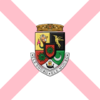
|
2015 | Royal standard | 1:1 variant of the usu i arru banner with the crowned arms in the center. Used as the royal standard of the King of the Valtirians. |
Regional flags
| Flag | Since | Flag of | Description |
|---|---|---|---|

|
2015 | Sabia | 1:1:1 horizontal tricolour of pink, white and blue with a stylized pink mermaid in the central band. It was adopted in 2015 to replace the old 2012 flag, which had been adopted when the region was founded and used the colours of the Holy Dussesh Empire's banner. |

|
2014 | Verona | 2:1:1 vertical tricolour of green, white and red (the Pashqari colours) with the Pashqar inscription "نازذر" (nazör; lit. "nation") on the upper right corner. It was adopted in 2014 and designed by Shassel Marlaryen (Shzël Ashaqür). |

|
2015 | Lycem | 2:1:1 vertical tricolour of red, green and black with a seven-pointed star akin to that on the Sabioveronese flag in the middle. The colours are considered traditionally "Lycene" colours, as they have historically represented the royal house of Kârjasary. Before the adoption of this flag, the region didn't count with an official banner to represent it. |

|
2015 | Gonn | 1:1 horizontal flag of white and red, with a green sun on the white field and a white crescent facing upwards on the red one. The colours are the same as in the Sabioveronese flag, representing the region's loyalty with Sabia and Verona. The green sun is, once again, a symbol of the House of Kârjasary, while the crescent represents beauty and elegance, as well as the balconies in Kotavari. |
City flags
| Flag | Since | Flag of | Description |
|---|---|---|---|

|
2015 | Alios | 1:1:1:1 horizontal banner of red, white, sky blue and eerie black. The red represents the Valtirian roots of Alios, the sky blue represents Argentina, the sky and new beginnings, the white is meant to represent the union between the new and the old, and the black represents wisdom and knowledge (the color of ink). |
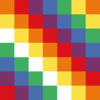
|
2013 | City of Elinore | Square whipala with an original pattern, designed by Anton Schubert-Moss. The whipala is meant to represent the indigenous peoples of the Americas. It was first adopted by the Free City of Elinore and then by the Elinore Prefecture. It's the oldest flag still in use in Sabia and Verona after the treteté itself. |
